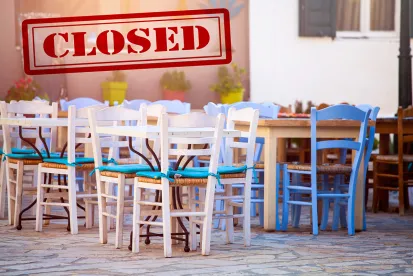Two federal cases in the Northern District of Ohio recently reached very different conclusions on whether the state’s COVID-19 shutdowns of restaurants permit valid claims for business interruption insurance coverage. Reviewing essentially the same facts and policy provisions, one court found for the insurer, holding no coverage to exist. The other found for the policyholder, awarding coverage. The opposite results will no doubt lead to further upcoming appellate activity in Ohio. The reasoning in these cases may also lead to further clarifications in Ohio about the rules for interpreting insurance policies.
A. Santo’s Italian Café, LLC v. Acuity Ins. Co., (Dec. 20. 2020), N.D. Ohio No. 1:20-CV-01192
In Santo’s case, Judge Pamela Barker dismissed the policyholder’s claims for business interruption coverage on two main grounds. First, the court found: (a) Santo’s failed to plead a threshold claim of “direct physical loss of or damage to” its insured premises, given the absence of any alleged “tangible” or “structural” damage beyond “economic losses”; and (b) even if a covered claim had been alleged, coverage was precluded by the “virus exclusion” in the coverage forms.
On the first issue, the court first noted the language of the insuring agreement in the Property Coverage Form:
“We will pay for direct physical loss of or damage to Covered Property at the premises described in the Declarations caused by or resulting from any Covered Cause of Loss.”
The Court further noted that the form listed “additional coverages” including the following:
“g. Business Income and Extra Expense
(1) We will pay for the actual loss of Business Income you sustain due to the necessary suspension of your operations during the period of restoration. The suspension must be caused by direct physical loss of or damage to property at the described premises. The loss or damage must be caused by or result from a Covered Cause of Loss.”
(Emphasis in the court’s quotations.)
Acuity Insurance argued there had been no “direct physical loss of or damage to property,” since there had been no allegation of “demonstrable, physical alteration” or “tangible alteration” of the property. (Santo’s Case Opinion and Order at p. 14.) On the other hand, Santo’s argued the concept of “physical loss” can include a “loss of functionality,” “lost operations or inability to use the business.” (Id. at 15.)
The Court found under Ohio law, these policy terms required the policyholder to allege and prove a “distinct, demonstrable physical alternation” of its property, beyond “mere economic effects.” (Id. at 24.) In support, it cited Mastellone v. Lightning Rod Mut. Ins. Co., 175 Ohio App. 3d 23, 40 (Ohio 8th Dist. Ct. App. 2008) (denying coverage for mold stains), where the court construed the similar term “physical injury” to require an adverse effect on the “structural integrity” of the property beyond mere “intangible” loss. (Santo’s Case Opinion and Order at pp. 17-20.) It also cited Universal Image Prods., Inc. v. Federal Ins. Co., 475 Fed. App’x 569, 573 (6th Cir. 2012) (denying coverage for a persistent odor from mold or bacteria), where the court interpreted the similar phrase “direct physical loss or damage” to require “tangible, physical losses” beyond mere “economic losses.” (Santo’s Case Opinion and Order at pp. 17-20.) The court rejected the invitation to rely on other states’ case law because Ohio law appears to differ. It added the claim would still “likely remain insufficient” under other states’ law given the lack of any “physical force on Santo’s property.” (Id. at 21.)
Santo’s also argued coverage could exist under the policy’s “Civil Authority Coverage.” This provision could provide coverage if Santo’s property were not damaged, so long as other local properties were damaged in a way that affected Santo’s. However, the court denied coverage under this provision as well, employing the same reasoning it used to deny Business Income coverage. It emphasized neither Santo’s property nor was any nearby property alleged or proven to have structural or tangible damage. (Id. at 26.)
On the second issue – the applicability of the virus exclusion – the court found further grounds for dismissal. It cited the terms of the exclusion, which state:
“1. We will not pay for loss or damage caused directly or indirectly by any of the following. Such loss or damage is excluded regardless of any other cause or event that contributes concurrently or in any sequence to the loss…
“i. Virus or Bacteria
(1) Any virus, bacterium, or other microorganisms that induces or is capable of inducing physical distress, illness or disease.”
Santo’s argued: (a) The Ohio Closure Orders caused the loss, not the COVID-19 virus; and (b) the exclusion is ambiguous because it does not reference the term “pandemic.” The court found the policyholders’ arguments to be unpersuasive. It noted the complaint acknowledged the Closure Orders were issued due to the spread of the COVID-19 virus and the pandemic arose from the same virus. (Id. at 30-32.) It further noted the exclusion’s broad terms and anti-concurrent causation language, which excludes damage caused “direct or indirectly” by the cited causes “regardless of any other cause or event that contributes” to it. (Id.)
In sum, the court found multiple reasons to deny business interruption coverage to Santo’s.
B. Henderson Road Restaurant Systems, Inc., v. Zurich Am. Ins. Co., (Jan. 19, 2021), N.D. Ohio No. 1:20-CV-1239
In the Henderson case, Judge Polster granted the policyholder’s motion for summary judgment, crediting the same key policyholder arguments that Judge Barker had rejected in Santo’s. The Henderson case thus found business interruption coverage to be available to a restaurant group under a policy issued by Zurich American Insurance Company (Zurich). The operative portions of the policy in Henderson read as follows (and are virtually identical to the key provisions interpreted in Santos):
“Business Income Coverage Form
“A. COVERAGE
“We will pay for the actual loss of ‘business income’ you sustain due to the necessary ‘suspension’ of your ‘operations’ during the ‘period of restoration.’ The ‘suspension’ must be caused by direct physical loss of or damage to property at a ‘premises.’ … The loss or damage must be directly caused by a ‘Covered cause of loss.’”
The Henderson court accepted the policyholder’s argument about the meaning, or at least the ambiguity, of the phrase “direct physical loss of” the real property. Interpreting what it found to be ambiguities, and construing them in the policyholder’s favor, the court agreed that the key phrase could mean something different than “damage to” the property. Thus, the court further agreed that the policyholders “lost their real property” under the policies’ terms “when the state governments ordered that the properties could no longer be used for their intended purpose.” (Henderson Opinion and Order at 18.) The court found it to be irrelevant that no permanent loss occurred. (Id. at 21.)
As for prior binding cases involving Ohio law, the court found none to be pertinent. It said none involve “interpreting the same policy language and applying it to real property.” (Id.) It discussed Mastellone and Universal Image as involving somewhat different terms than those at issue here. the court noted Zurich cited another case involving the same terms as the Henderson policy, Schmidt v. Travelers Indemnity Co. of America, 101 F. Supp.3d 768, 781 (S.D. Ohio 2015). The Schmidt case did indeed apply the phrase “direct physical loss” to the facts involving some fraudulent cashier’s checks. The Schmidt court found no covered loss where fraudulent checks “were not physically lost or damaged.” But the Henderson court simply stated, “the application of the language ‘loss of’ to personal property is different than it is to real property.” (Id. at 20.) It did not explain why the analysis is different for real versus personal property, but it concluded that it “is different.”
As for the “microorganisms” exclusion that existed in the policy, Zurich argued that it barred coverage here. The court first quoted it as follows:
“12. Microorganisms
We will not pay for loss or damage consisting of, directly or indirectly caused by, contributed to, or aggravated by the presence, growth, proliferation, spread, or any activity of ‘microorganisms,’ unless resulting from fire or lightning. Such loss or damage is excluded regardless of any other cause or event, including a ‘mistake’ or ‘malfunction,’ or weather condition, that contributes concurrently or in any sequence to the loss, even if such other cause or event would otherwise be covered.”
Analyzing this exclusion, the court rejected its application here, stating: “Plaintiffs’ restaurants were not closed because there was an outbreak of COVID-19 at their properties; they were closed as a result of governmental orders.” (Id. at 27-28) It said that the microorganisms exclusion “did not clearly exclude loss of property caused by a government closure,” faulting Zurich for not being specific enough to reference “government closures” in the exclusion. (Id.) The court also noted the parties’ stipulation that “none of Plaintiffs’ Insured Premises were closed as a result of the known or confirmed presence of SARS-CoV-2 or COVID-19 at any of the Insured Premises.” (Id. at 27.)
The Court did not cite any language in the exclusion as requiring a microorganism to be present at the insured’s premises in order for coverage to be excluded. Nor did it cite any ambiguity on that point. But it did reference a Zurich submission to the Department of Insurance as discussing this exclusion’s intended application to viruses and bacteria on the insured’s premises. (Id. at 28-29.)
C. Implications for Policy Interpretation Rules
It is interesting the Henderson court cites the well-known principle of interpreting ambiguities in favor of the policyholder (id. at 16-17) but then relies on extra-contractual materials in aid of interpretation without citing any ambiguity on the point at issue. (Id. at 27-30.) The court’s reasoning on the exclusion raises three interesting, related questions about the rules for interpreting insurance policies:
-
If there is no ambiguity in a policy, may a court consult extra-contractual materials to interpret and explain it?
-
If there is ambiguity, may a court consult extra-contractual materials to interpret it, or does an ambiguity require immediate interpretation in favor of the policyholder to the extent reasonable?
-
May an insurer provide extra-contractual materials to the court in aid of policy interpretation, or is that option limited to policyholders?
Note that Santo’s court stated several principles pertinent to policy interpretation, including that “if a contract is ambiguous, a court may consider extrinsic evidence to ascertain the parties’ intent.’” (Santos Opinion and Order at 13, citing Westfield Ins. Co. v. Galatis, 797 N.E.2d 1256, 1261 (Ohio 2003)). These questions about policy interpretation may prove critical on appeal of this case.
D. Conclusion
The Santo’s and Henderson decisions are polar opposites, from two different judges, albeit both in the Northern District of Ohio, less than a month apart. Addressing coverage for COVID-19 business shutdowns, one finds business interruption coverage requires “structural” or “tangible” damage beyond “economic loss.” The other finds a “physical loss” occurs when a property cannot be used for its intended purposes during a pandemic-related shutdown. Likewise, one finds losses from governmental closure orders are sufficiently related to COVID-19 to fall under a virus exclusion. The other finds an exclusion for microorganisms is inapplicable due the insurer’s failure to specifically reference government closures.
Fully aware of the controversy and importance of these decisions, the Henderson court provided for interlocutory appeal of its coverage ruling. Insurers and policyholders in Ohio thus await the further resolution of these key issues and clarification of the pertinent rules of policy interpretation by the Sixth Circuit or the Ohio Supreme Court.



 />i
/>i
